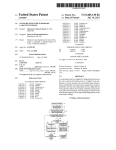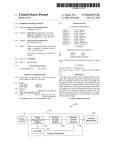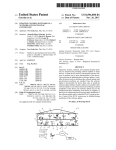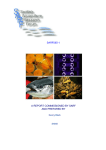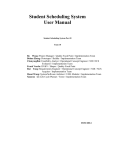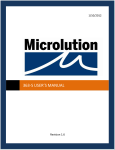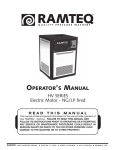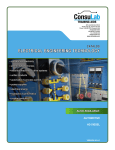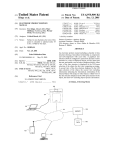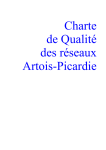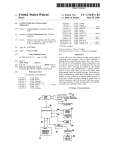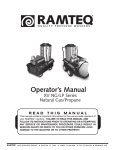Download Appliance control with automatic damper detection
Transcript
US008074892B2 (12) United States Patent (10) Patent N0.: (45) Date of Patent: Bracken et al. (54) (56) APPLIANCE CONTROL WITH AUTOMATIC DAMPER DETECTION References Cited 3,849,350 4,204,833 4,256,257 4,267,965 4,299,554 4,324,944 RE30,936 4,333,002 4,460,329 4,508,261 Brent Chian, Plymouth, MN (US); Timothy J. Nordberg, Plymouth, MN (US); Henry E. Troost, River Falls, WI (Us) (73) Assignee: Honeywell International Inc., Morristown, NJ (US) Filed: (Continued) U.S. Appl. No. 10/911,151, ?led Aug. 3, 2004. (Continued) Primary Examiner * Marc Norman (74) Attorney, Agent, or Firm * Seager, Tufte & Wickhem LLC Jul. 8, 2010 (57) Related U.S. Application Data ABSTRACT Methods and systems for operating a fuel ?red appliance that Continuation of application No. 11/276,121, ?led on Feb. 15, 2006, now Pat. No. 7,721,972, which is a may include an optional hardware component such as a damper are disclosed. In some cases, the presence of the continuation-in-part of application No. 11/306,875, optional hardware component is detected, and it is deter mined whether the optional hardware component is required for future operation of the fuel ?red appliance. The fuel ?red appliance may be operated normally if the optional hardware ?led on Jan. 13, 2006, now Pat. No. 7,747,358. Int. Cl. F23N 5/00 component is present and required, or, in some cases, if the optional hardware component is determined to be not (2006.01) U.S. Cl. ..... .. 236/1 H; 236/11; 236/15 R; 236/21 R; required. If the optional hardware component is absent but required, normal operation of the fuel ?red appliance may be 236/46 E (58) 3/1990 OTHER PUBLICATIONS Prior Publication Data US 2010/0173252 A1 (52) 0356609 Mar. 23, 2010 (65) Matsko KmetZ etal. Pinkerton Everett Williams Wiehrich et a1. KmetZ et :11. Kozak Trent Blank FOREIGN PATENT DOCUMENTS EP (21) Appl. N0.: 12/729,778 (51) ll/l974 5/1980 3/1981 5/1981 ll/l98l 4/1982 5/1982 6/1982 7/1984 4/1985 (Continued) This patent is subject to a terminal dis claimer. (63) A A A A A A E A A A Subject to any disclaimer, the term of this patent is extended or adjusted under 35 U.S.C. 154(b) by 0 days. (22) *Dec. 13, 2011 U.S. PATENT DOCUMENTS 3,847,350 A ll/l974 Thompson (75) Inventors: Scott J. Bracken, Long Lake, MN (US); Notice: US 8,074,892 B2 Field of Classi?cation Search ................ .. 236/1 H, stopped. 236/10,11,15 R, 20 R, 21 R, 46 E See application ?le for complete search history. 20 Claims, 8 Drawing Sheets 140 Detect if Damper is Present Damper Present was Darn per Previously Detected ? Stop Operation of the Fuel [150 Fired Appliance Controlling the Fuel Fired Appliance in Controlling the Fuel Fired Appliance in Accordance with a First Control Accordance with a Second Control Algorithm Algorithm US 8,074,892 B2 Page 2 US. PATENT DOCUMENTS 4,511,790 4,538,980 4,588,875 4,692,598 4,696,639 4,734,658 4,742,210 4,752,210 4,770,629 4,834,284 4,835,670 4,880,376 4,984,981 4,986,468 5,007,156 5,039,006 5,276,630 5,442,157 5,622,200 5,660,328 5,797,358 5,896,089 5,968,393 5,975,884 6,048,193 6,053,130 6,059,195 6,208,806 6,261,087 6,271,505 6,293,471 6,350,967 RE37,745 D> B1 B1 B1 B1 B1 E 4/1985 9/1985 5/1986 9/1987 9/1987 3/1988 5/1988 6/1988 9/1988 5/1989 5/1989 11/1989 1/1991 1/1991 4/1991 8/1991 1/1994 8/1995 4/1997 8/1997 8/1998 4/1999 10/1999 11/1999 4/2000 4/2000 5/2000 3/2001 7/2001 8/2001 9/2001 2/2002 6/2002 KoZak Hoyme KoZak et al. Yoshida et al. Bohan, Jr. Bohan, Jr. Tsuchiyama et al. Trent Bohan, Jr. Vandermeyden Adams et al. Bartels et al. Pottebaum Deisinger Hurtgen Habegger Baldwin et al. Jackson SchulZe Momber Brandt et al. Bowles Demaline Dugger Juntunen et al. Shellenberger 6,560,409 B2 B1 B2 B2 B2 B1 6,701,874 6,955,301 6,959,876 7,205,892 7,221,862 2001/0025349 2001/0031138 2002/0132202 2004/0176859 2004/0185770 2005/0077368 2005/0161516 2006/0214015 2007/0023333 A1 A1 A1 A1 A1 A1 A1 A1 A1 5/2003 Troost, IV Schultz et al. Munsterhuis et al. Chian et al. Luebke et al. Miller et al. 3/2004 10/2005 11/2005 4/2007 5/2007 9/2001 10/2001 9/2002 9/2004 9/2004 4/2005 7/2005 9/2006 2/2007 Sharood et al. Troost, IV Clifford Chian et al. Soeholm et al. Zak et al. Munsterhuis Furukawa et al. Mouhebaty et al. FOREIGN PATENT DOCUMENTS EP GB 0356609 2211331 3/2006 6/1989 OTHER PUBLICATIONS Honeywell D896 Automatic Vent Damper, Product Data, 12 pages, 1997. Honeywell S8610U Universal Intermittent Pilot Module, Installation Instructions, 20 pages, Aug. 1996. Johnson Controls Q135 Automatic Flue Damper System, 8 pages, Adams et al. 1998. Langford LennoX, “Network Control Panel (NCP), User’s Manual,” 18 pages, Bird et al. Henderson Stettin et a1. Scott Brandt et al. Nov. 1999. US . Appl. No. 10/911,151, entitled “Water Heater and Control,” ?led Aug. 3, 2004. Weil-McLain, Technical Services Bulletin No. SB201, 2 pages, Nov. 20, 2002. US. Patent Dec. 13, 2011 Sheet 1 of8 US 8,074,892 B2 40—~ ?\ I ___'_ 24 _ ____ [34 1/26 _'_'__J___ ____ 14" 42 v53 figure 1 US. Patent Dec. 13, 2011 Sheet 2 of8 US 8,074,892 B2 Damper Control Signa|(s) 53* Water Heater 59-—~ Input Slgnals l 50 65w / I’ l _ _ ‘l M_en_'1o_ryJ Processor [54 [56 Damper Function Detector Control 63 l Water Heater Control Signals figure 2 US. Patent Dec. 13, 2011 Sheet 3 of8 US 8,074,892 B2 @m385 US. Patent Dec. 13, 2011 Sheet 4 of8 _ mEHmwnEoN¢ mEHwmanEoNv US 8,074,892 B2 mwEHmonENw US. Patent Dec. 13, 2011 120‘ Sheet 5 of8 l Enter US 8,074,892 B2 l l ll Detect if Damper : is Present \122 124 Is Damper Present '2 \ ll ll Controlling the Fuel Fired Appliance in Controlling the Fuel Fired Appliance in Accordance with a Accordance with a First Control Second Control Algorithm Algorithm figure 5 US. Patent Dec. 13, 2011 Sheet 6 of8 US 8,074,892 B2 140 Detect if Damper is Present k142 144 Is Damper Present ? 148 Was Damper Yes Previously Detected 152\ Stop Operation 146 \ of the Fuel v 150 Fired Appliance f Controlling the Fuel Fired Appliance in Controlling the Fuel Fired Appliance in Accordance with a Accordance with a First Control Second Control Algorithm Algorithm figure 6 US. Patent Dec. 13, 2011 Sheet 7 of8 160 Detect if Damper is Present 166 Was Damper Previously Detected Stop Operation of the Fuel Fired Appliance 170 figure 7 US 8,074,892 B2 US. Patent Dec. 13, 2011 180‘1 Sheet 8 of8 Enter US 8,074,892 B2 ) ll Operate Fuel Fired Appliance ‘' \182 Detect if Damper is Present \184 186 Is Damper Present Damper Previously Been Present Period of Check state of damper present flag in non volatile memory 190\ Stop Operation _ of the Fuel Determ'ne Phat Fired Appliance Damper IS Required |—Set a Damper—| |_ _| Present Flag in 196 Non-Volatile |_ _Me?’ry_ JLigi figure 8 US 8,074,892 B2 1 2 APPLIANCE CONTROL WITH AUTOMATIC DAMPER DETECTION times for a minimum period of time), determining that the This application is a continuation of Us. patent applica tion Ser. No. 11/276,121, entitled “Applicant Control With Automatic Damper Detection”, ?led Feb. 15, 2006, Which is a continuation-in-part of Us. patent application Ser. No. damper if a damper Was previously installed. As such, the method may further include the steps of: operating the fuel damper is noW required. In some cases, it may not be desir able to alloW the fuel ?red appliance to operate Without a ?red appliance if the damper is present and required; operat ing the fuel ?red appliance if the damper is not present and not required; and ceasing to operate the fuel ?red appliance nor mally if the damper is not present but required. The ceasing to 11/306,875, entitled “Building Equipment Component Con trol With Automatic Feature Detection”, ?led Jan. 13, 2006, both of Which are incorporated herein by reference. operate step may include, for example, preventing or stopping the fuel ?red appliance from combusting fuel in the combus tion chamber. This may be accomplished by, for example, FIELD inhibiting an igniter (if present) from igniting the fuel, pre venting a fuel valve that supplies fuel to the combustion The present invention relates generally to fuel ?red appli ances such as Water heaters, furnaces and boilers, and more chamber from opening, turning off a pilot ?ame (if present), particularly, to control systems and methods for controlling such fuel ?red appliances. terminating all poWer to the fuel ?red appliance, and/or any other suitable method of ceasing to operate the fuel ?red BACKGROUND appliance in a normal manner, as desired. In some cases, once a damper is detected for at least the 20 (e. g. atmosphere) via a vent pipe or the like. During off-cycle periods, the fuel ?red appliances can lose signi?cant heat through the vent pipe or chimney by natural convection and/ or conduction. To help reduce these losses, a damper can be installed either at the ?ue exit or in the vent pipe. Alterna tively, tWo or more dampers may be used, such as a ?ue damper installed upstream of a draft diverter of the fuel ?red appliance, and a vent damper installed doWnstream of the draft diverter. In some cases, electric motor controlled ?ue dampers may be used and controlled by a damper controller or the like. In some cases, the damper(s) may be controlled to open When combustion starts, and close immediately or sometime after 25 state of the damper present ?ag may be saved, even in the event of a poWer failure. As noted above, the damper present ?ag, When set, may indicate that a damper is noW required in order to operate the fuel ?red appliance. The damper present ?ag may be active loW or high, as desired. During subsequent operation of the fuel ?red appliance, the 30 status of the damper present ?ag may be checked to see if a damper Was previously detected and noW deemed to be required. If a damper is deemed to be required, the fuel ?red appliance may be operated normally if the damper is present, 35 but stopped or otherWise not operated normally if a damper is not currently present. If the status of the damper present ?ag does not indicate a damper Was previously present, and thus the presence of the damper is not required, the fuel ?red appliance may be operated normally Without a damper present. combustion stops. This may help minimiZe the off-cycle heat losses that may occur through the vent pipe or chimney of many fuel ?red appliances. minimum period of time, a damper present ?ag is set in a memory, such as a non-volatile memory. The damper present ?ag may include a single bit in the memory, or a collection of bits, as desired. When provided in a non-volatile memory, the Commercial and residential buildings often use fuel ?red appliances such as Water heaters, furnaces and boilers. In many cases, the fuel ?red appliances include a combustion chamber With a ?ue that is vented to outside of the building 40 In some cases, the damper may be a motoriZed damper that has one or more conductors ?tted to a ?rst connector. The one SUMMARY or more conductors may provide poWer and/ or control signals to the motoriZed damper. A damper detector may be coupled The folloWing summary of the invention is provided to facilitate an understanding of some of the innovative features unique to the present invention and is not intended to be a full 45 to a second connector that is adapted to be selectively con nected to the ?rst connector of the motoriZed damper. A controller for the fuel ?red appliance may include, or be description. A full appreciation of the invention can be gained coupled to, the damper detector. When the damper detector by taking the entire speci?cation, claims, draWings, and detects that the ?rst connector is connected to the second connector, a damper present ?ag may be set in a memory, recording that a damper has been detected. In some cases, the abstract as a Whole. The present invention relates generally to fuel ?red appli 50 ances, and more particularly, to control systems and methods damper present ?ag is not set until the damper detector detects for operating such fuel ?red appliances. The fuel ?red appli that the ?rst connector is connected to the second connector for a minimum period of time. ance may be, for example, a Water heater, a furnace, a boiler, or any other fuel ?red appliance as desired. The fuel ?red appliance may have a combustion chamber With a ?ue exit The controller may include, or may be coupled to, the 55 damper detector and may be adapted to read the damper present ?ag from memory. The controller may stop normal operation of the fuel ?red appliance if the state of the damper present ?ag is set and the damper detector detects that the ?rst 60 The controller may alloW normal operation of the fuel ?red appliance if the state of the damper present ?ag is not set and the damper detector detects that the ?rst connector is not that is vented to atmosphere (e.g. outside the building) via a vent pipe or the like. In some embodiments, a controller is provided that con trols the fuel ?red appliance, and in some cases, an optional damper. The optional damper may, for example, be a vent or connector is no longer connected to the second connector. ?ue damper that, When installed, selectively opens and closes the exhaust path to atmosphere in the vent and/or ?ue. In some cases, the damper may be installed in, for example, the ?ue exit of the fuel ?red appliance, and/ or in the vent pipe, to help minimize the off-cycle heat losses of the fuel ?red appliance. One illustrative method includes the step of detecting if an optional damper is present, and if a damper is present (some connected to the second connector or, in some cases, has not been connected to the second connector for at least a mini 65 mum period of time. In another illustrative embodiment, the presence of a damper may be detected. If a damper is detected, the fuel ?red US 8,074,892 B2 3 4 appliance may be controlled in accordance With a ?rst control Insulating layer 14 may be located betWeen outer surface 32 of tank 12 and external shell 16. Insulating layer 14 limits algorithm. If a damper is not detected, the fuel ?red appliance or otherWise minimiZes the heat loss of the heated Water from passing from tank 12 to the outside World. Bonded to the inside of inner surface 22 is rust inhibiting liner 30. In addi tion, tank 12 may have a sacri?cial anode rod (not illustrated) may be controlled in accordance With a second control algo rithm. In some cases, normal operation of the fuel ?red appli ance may be stopped if a damper is detected as present over a minimum period of time, and then subsequently not detected. to keep tank 12 from corroding. Tank 12 also has a top surface 34 and a bottom surface 36. BRIEF DESCRIPTION Dip tube 24 and output pipe 26 pass through top surface 34. Output pipe 26 extends through top surface 34 to a second The invention may be more completely understood in con predetermined distance from bottom surface 36. This second predetermined distance may be fairly close to top surface 34. Positioning output pipe 26 close to top surface 34 alloWs the sideration of the following detailed description of various embodiments of the invention in connection With the accom panying drawings, in Which: hotter Water, Which may be the hottest Water in tank 12, to exit upon demand. In operation, When the hot Water is demanded, fresh Water ?oWs into dip tube 24 to the bottom of tank 12 and FIG. 1 is cutaWay side vieW of an illustrative fuel ?red appliance; FIG. 2 is a block diagram of an illustrative controller for pushes or otherWise causes the hotter Water at the top of tank operating and/ or controlling the fuel ?red appliance of FIG. 1; FIG. 3 is a schematic diagram of an illustrative damper detector; 20 12 to exit through output pipe 26. Dip tube 24 extends through top surface 34 to a predeter mined distance from bottom surface 36. This predetermined distance may be fairly close to bottom surface 36. Positioning FIGS. 4A-4C shoW graphs of illustrative feedback signals for the damper detector of FIG. 3 under various operating the exit of dip tube 24 close to bottom surface 36 alloWs the conditions; fresh, cold or ambient Water to enter tank 12 near bottom FIG. 5 is a ?oW diagram of an illustrative method for controlling a fuel ?red appliance; 25 FIG. 6 is a ?oW diagram of another illustrative method for controlling a fuel ?red appliance; FIG. 7 is a ?oW diagram of another illustrative method for controlling a fuel ?red appliance; and FIG. 8 is a ?oW diagram of another illustrative method for controlling a fuel ?red appliance. While the invention is amenable to various modi?cations and alternative forms, speci?cs thereof have been shoWn by Way of example in the draWings and Will be described in detail. It should be understood, hoWever, that the intention is 30 surface 36. This helps prevent the cold or ambient Water from mixing and cooling the hotter Water near top surface 34. In practice, dip tube 24 may be located about three quarters of the distance from top surface 34 to bottom surface 36. Because the cooler Water entering tank 12 is denser than heated Water, the cooler Water tends to sink to the bottom of tank 12, Where it may be heated. Heater 18 heats tank 12, Which in turn heats any Water inside tank 12. In the illustrative embodiment, heater 18 may be one or more gas-?red burners located in a combustion 35 chamber 43. In the exemplary gas-?red Water heater 10 shoWn in FIG. 1, heater 18 may have a gas-?oW valve (not shoWn), a burner 38 and an ignition source 40. The gas-?oW valve may be a solenoid-controlled valve, a linear actuated valve, a motor actuated valve, or any other valve capable of not to limit the invention to the particular embodiments described. On the contrary, the intention is to cover all modi ?cations, equivalents, and alternatives falling Within the spirit and scope of the invention. 40 supplying gas to burner 38. Ignition source 40 may be a pilot light, a solid-state igniter, an electric heat element, or any other ignition source capable of igniting gas. The heat output of heater 18 may be controlled by burner ori?ce siZe, gas pressure, and/or time. To produce heat in the DESCRIPTION The folloWing description should be read With reference to the draWings Wherein like reference numerals indicate like elements throughout the several vieWs. The draWings, Which are not necessarily to scale, depict selected embodiments and tion source 40 ignites the gas. The gas Will continue to burn are not intended to limit the scope of the invention. Although until the supply of gas is terminated. The burner 38, Which is gas-?red Water heater, gas ?oWs into burner 38 in the com bustion chamber 43 through the gas-?oW valve, Where igni examples of construction, dimensions, and materials are situated in combustion chamber 43, may be in ?uid commu illustrated for the various elements, those skilled in the art Will nication With an exhaust outlet, such as a ?ue 40. The ?ue 40 may be coupled to a vent pipe 45 that vents combustion gases recogniZe that many of the examples provided have suitable 50 exiting from the combustion chamber 43 to atmosphere (e.g. outside of the building). alternatives that may be utiliZed. The present invention relates generally to fuel ?red appli ances such as Water heaters, furnaces and boilers, and more In some cases, the combustion gases may be vented particularly, to control systems and methods for such fuel ?red appliances. Merely for illustrative purposes, and not to be intended as limiting in any manner, the present invention through the ?ue 40 and vent pipe 45 through natural convec tion. Alternatively, a fan or like (not shoWn) may be provided to help force the combustion gases through the ?ue 40 and vent pipe 45 to atmosphere. In either case, during off-cycle periods, the Water heater 10 can lose heat through the ?ue 40 and vent pipe 45 to atmosphere by natural convection and conduction. To help reduce these losses, a damper 49 may be 55 Will be discussed With respect to a gas ?red Water heater, although as indicated above, any suitable gas ?red appliance may be used, as desired. FIG. 1 is cutaWay vieW of an illustrative Water heater 10. The illustrative Water heater 10 includes a tank 12, an insu lating layer 14, an external shell 16, a heater 18, and a con troller 50. Tank 12 holds Water that is to be heated and may be constructed of steel or other heat conducting material. Illus trative tank 12 has an inner surface 22, an input supply tube or dip tube 24, an output conduit or pipe 26, a drainage valve 28, a rust inhibiting liner 30, and an outer surface 32. 60 installed either at the ?ue 40 exit or in the vent pipe 45. Alternatively, tWo or more dampers may be used, such as a ?ue damper (not shoWn) installed up stream of a draft diverter (if present) of the Water heater, and a vent damper 49 installed 65 doWnstream of the draft diverter (if present). In some cases, one or more electric motor controlled damp ers may be used. The damper 49 shoWn in FIG. 1 may be one US 8,074,892 B2 5 6 such electric motor controlled damper. The damper 49 may be tive, and it is contemplated that any suitable detection method or signal may be provided by the damper detector block 54, as desired. One illustrative method of the present invention includes controlled by a controller 50 or the like via Wiring 53. In some cases, the damper(s) 49 may be controlled to open When combustion in the combustion chamber 43 starts, and close immediately or sometime after combustion stops. This may help minimize the off-cycle heat losses that may occur the step of detecting if damper 49 is present using damper detector block 54, and if the damper 49 is present, sometimes through natural convection through the vent pipe 45 to atmo for at least a minimum period of time. In some embodiments, sphere. the minimum period of time may represent, for example, a FIG. 2 is a block diagram of an illustrative controller 50 for operating and/or controlling the Water heater 10. The illustra tive controller 50 includes a damper detector block 54, a function control block 56, a processing block 52, and a memory block 58. The functions of the illustrative controller 50 may be implemented in hardWare, softWare or a combina tion thereof Under some circumstances, the damper detector predetermined minimum elapse time period, a predetermined minimum number of heating cycles of the Water heater 10 (eg one, tWo, three or greater), or any other minimum time period as desired, Whether predetermined or not. If the damper detector block 54 detects the presence of the damper 49, sometimes for at least the minimum period of time, the processing block 52 may determine that the damper 49 is required during sub sequent operation of the Water heater 10. block 54, the function control block 56, the processing block 52, and/ or the memory block 58 may be integrated on a single In some cases, it may not be desirable to alloW the Water device platform, but this is not required. In the illustrative embodiment, the controller 50 may con trol the operation of the Water heater 10. For example, the controller 50 may control the ignition source or pilot of the Water heater, control the opening and closing of a gas valve, 20 control the opening and closing of the optional damper 49, as Well as control the operation of other components, depending on the application. The controller 50 may provide one or more 25 The ceasing to operate step may include, for example, Water heater control signal signals, as shoWn at 63, to various components of the Water heater 10, and may receive one or more Water heater input signals 65 from Water heater 10, such as one or more sensor (e.g. temperature sensor) input signals, one or more user interface input signals, etc. 30 The processing block 52 of the controller 50 may, in some cases, process one or more of the input signals 65, and in response, provide appropriate control signals 63 to the vari ous Water heater 10 components, sometimes through the function control block 56. For example, and in some cases, the function control block 56 may be adapted to control the 35 40 The memory block 58 may be included internally to the processing block 52, and/or may be separately provided, as desired. The memory block 58 may store programming, 45 damper present ?ag and/or the like. The memory block 58 interrupted or turned off. The memory block 58 may include, 50 memory, RAM memory, registers, and/ or any other type of memory as desired. 55 damper Was previously detected and noW deemed to be required for future operation of the Water heater 10. If a damper 49 is deemed to be required, the Water heater 10 may does not indicate a damper 49 Was previously present and is therefore not noW required, the Water heater 10 may be oper ated normally Without a damper 49 present. coupled to, the processing block 52 of the controller 50, if desired. Under some circumstances, the damper detector In some cases, the damper 49 may be a motoriZed damper that has one or more conductors 53 ?tted to a ?rst connector 59. The one or more conductors 53 may convey poWer and/ or block 54 may be a detection circuit, Which may provide an electrical signal to the processing block 52 that indicates Whether a damper 49 is present and connected. For example, and as Will be discussed in further detail beloW, the damper detector block 54 may provide a ?rst electrical signal to the processing block 52 When a damper 49 is present and connected to the controller 50, and no signal or a second signal When the damper 49 is not present or not connected to the controller 50. HoWever, this is only illustra During subsequent operation of the Water heater 10, the be operated normally if the damper 49 is still present, but stopped or otherWise not operated normally if the damper 49 is not currently present. If the status of the damper present ?ag able programmable read-only memory (EEPROM), ?ash The damper detector block 54 may be used to detect When a damper (such as damper 49 of FIG. 1) is present and con nected. The damper detector block 54 may be internal, or the damper present ?ag may be maintained, even in the event of a poWer failure. As noted above, the damper present ?ag, When set, may indicate that a damper 49 is noW required in order to operate the Water heater 10 normally. The damper present ?ag may be active loW or high, as desired. processing block 52 may read up the status of the damper present ?ag from the memory block 58, and check to see if a may, in some cases, include a non-volatile memory that retains its contents even after poWer to the memory 58 is for example, a read-only memory (ROM), electrically eras to operate the Water heater 10 in a normal manner, as desired. In some cases, once a damper 49 is detected, sometimes for single bit in the memory block 58, or a collection of bits, as desired. When provided in a non-volatile memory, the state of required. parameter values, historical data, one or more ?ags such as a preventing or stopping the Water heater 10 from combusting fuel in the combustion chamber 43. This may include manipu lating the control signals 63 to, for example, inhibit an igniter (if present) from igniting the fuel, prevent a fuel valve that supplies fuel to the combustion chamber 43 from opening, turn off a pilot ?ame (if present), terminate all poWer to the Water heater 10, and/ or any other suitable method of ceasing at least a minimum period of time, a damper present ?ag is set in memory block 58. The damper present ?ag may include a ignition of the burner and/or the ignition source by either alloWing ignition of the Water heater 10 or not alloWing igni tion of the Water heater 10. It is contemplated that the pro cessing block 52 may include a microprocessor, but this is not heater 10 to continue to operate Without the damper 49 if the damper 49 Was previously installed and detected. As such, the method may further include the steps of: operating the Water heater 10 if the damper 49 is present and determined to be required; operating the Water heater 10 if the damper 49 is not present and not determined to be required; and ceasing to operate the Water heater 1 0 if the damper 49 is not present and determined to be required. 60 control signals to the damper 49. The damper detector block 54 may be coupled to a second connector 61, Which is adapted to be selectively connected to the ?rst connector 59 of the damper 49. The processing block 52 may include, or be coupled to, the damper detector block 54. When the damper 65 detector block 54 detects that the ?rst connector 59 is con nected to the second connector 61 (sometimes for a minimum period of time, minimum number of heating cycles, etc.), a US 8,074,892 B2 8 7 damper present ?ag may be set in the memory block 58, recording that the damper 49 has been detected. The processing block 52 may be adapted to read the damper present ?ag from memory block 58. This may occur in real time, periodically, at the beginning or end of a heating cycle, and/or at any other time, as desired. The processing block 52 may stop normal operation of the Water heater 10 if the state of the damper present ?ag is set and the damper To detect Whether a damper is present and connected, the ?rst connector 76 may have a line 80 that is connected to a ?rst voltage divider 82. The ?rst voltage divider 82 may include a ?rst resistor 84 and a second resistor 86 connected in series.A damper present feedback signal 88 may be taken from the ?rst voltage divider 82 and provided to the micro-controller 62, as shoWn. When a damper 64 is provided, line 80 of the ?rst connector 76 is connected to the second connector 74. Inside detector block 54 detects that the ?rst connector 59 is no of the second connector 74, or inside the damper 64 assembly longer connected to the second connector 61. The processing block 52 may alloW normal operation of the Water heater 10 if the state of the damper present ?ag is not set and the damper minal of the motor 72. Thus, if the ?rst connector 76 is connected to the second connector 74 (eg the damper is detector block 54 detects that the ?rst connector 59 is not present), line 80 Will be coupled to the “C” signal 68. HoW itself, line 80 may be connected to the common or “C” ter ever, if the ?rst connector 76 is not connected to the second connected to the second connector 61 or, in some cases, has not been connected to the second connector 61 for at least a minimum elapse period of time, a minimum number of heat ing cycles, etc. In some embodiments, if a damper 49 is detected by the damper detector block 54, the controller 50 may control the Water heater 10 in accordance With a ?rst control algorithm. 20 The ?rst control algorithm may, for example, be adapted to control the Water heater 1 0 in conjunction With the damper 49. If a damper 49 is not detected by the damper detector block 54, the controller 50 may control the Water heater 10 in accordance With a second control algorithm. The second con damper. 25 trol algorithm may, for example, be adapted to control the Water heater 10 Without the damper 49. In some cases, the normal operation of the Water heater 10 may be stopped if a damper 49 is detected by the damper detector block 54, some times for a minimum period of time, and then subsequently connector 74 (eg the damper is not present), line 80 Will be pulled to ground via the ?rst voltage divider 82. The illustrative damper detector 60 may also be con?gured to detect When the damper 64 has reached an end position (e.g. fully open position). The damper 64 may include an end detect sWitch 89, Which in the illustrative embodiment, is closed When the damper has reached an end position (eg a fully open position) and the motor has ?nished moving the 30 In the illustrative embodiment, the ?rst connector 76 may have a line 90 that is connected to a second voltage divider 92. The second voltage divider 92 may include a ?rst resistor 94 and a second resistor 96 connected in series. A damper end detect feedback signal 98 may be taken from the second voltage divider 92 and provided to the micro-controller 62, as shoWn. When a damper 64 is provided, line 90 of the ?rst not detected. connector 76 is connected to the second connector 74. Inside FIG. 3 is a schematic diagram of an illustrative damper detector 60. The illustrative damper detector 60 includes a of the second connector 74, or inside the damper 64 assembly micro-controller 62, an optional damper 64, a damper relay 70, an end detect sWitch 89, and tWo voltage dividers 84 and 35 itself, line 90 may be connected to one terminal of the end detect sWitch 89 as shoWn. The other terminal of the end detect sWitch may be connected to the “R” terminal of the motor 72. Thus, When a damper 64 is provided, and the ?rst 92. In the illustrative embodiment, poWer is supplied by a 24V connector 76 is connected to the second connector 74, line 90 AC poWer signal including an “R” signal 66 and a common “C” signal 68. PoWer signals R 66 and C 68 may be a 24-volt Will be coupled to the “R” signal 66 When the end detect sWitch 89 is closed (eg the damper has reached a fully open AC poWer signal, typically provided by a step doWn trans former, With the R and C signals 180 degrees out of phase 40 In this con?guration, the damper end detect feedback sig nal 98 Will generally folloW the damper activation signal 78, relative to one another. In the illustrative embodiment, the C signal 68 is coupled to a C terminal of a ?rst connector 76, and the R signal 66 is coupled to an R terminal of the ?rst con nector 76. The illustrative damper 64 includes a motor 72 for moving the damper betWeen an open position and a closed position. The motor 72 includes poWer inputs R and C. In the illustra tive embodiment, the R input of the motor 72 is coupled to an R terminal of a second connector 74, through relay 70. The C input of the motor 72 is coupled to a C terminal of a second connector 74. When the damper is provided, the second con nector 74 is coupled to the ?rst connector 76, Which electri cally connects the R and C terminals of the ?rst connector 76 to the R and C terminals of the second connector 74. but it does not have to if the damper motor 72 is broken. The damper end detect feedback signal 98 Will also be delayed 45 air How) the end detect sWitch 89 is closed providing “R” to the voltage divider 92. If a damper 64 is not provided, the ?rst 50 55 the C signal 68, the damper present feedback signal 88, and the damper actuation feedback signal 98, When there is no damper 64 present and the damper actuation relay 70 is open. Referenced from the ?oating controller ground, the R signal 60 damper activation signal 78, Which selectively closes the position of the damper 64. connector 76 is not connected to the second connector 74, and line 90 Will be pulled to ground via the second voltage divider. FIG. 4A-4C are graphs shoWing illustrative feedback sig nals for the damper detector 60 of FIG. 3 under various conditions. FIG. 4A is an illustrative graph of the R signal 66, terminal, Which in the illustrative embodiment, is coupled to the control input of relay 70. Thus, When a damper 64 is provided, the micro-controller 62 selectively activates the relay 70 and supplies the R signal 66 to the R terminal of the motor 72, thereby activating the motor 72 and moving the relative to the damper activation signal 78 due to the time it takes for the motor 72 to turn the damper to the fully open position. Generally When the damper is fully open (alloWing During operation, and in the illustrative embodiment, the micro-controller 62 selectively supplies a damper activation signal 78. The damper activation signal 78 is coupled to a damper activation terminal of the ?rst connector 76. The second connector 74 has a corresponding damper activation position). 65 66 and the C signal 68 appear like half Wave recti?ed 24-volt AC poWer signal 180 degrees out of phase relative to one another. Because the damper is not present in FIG. 4A, and referring back to FIG. 3, the ?rst connector 76 is not con nected to the second connector 74, and thus line 80 is pulled to ground via the ?rst voltage divider 82. Thus, the damper present feedback signal 88 Will also be pulled to ground, as shoWn in FIG. 4A. LikeWise, because the ?rst connector 76 is not connected to the second connector 74, line 90 is pulled to US 8,074,892 B2 10 ground via the second voltage divider, and the damper actua dance With a ?rst control algorithm, and passes control back tion feedback signal 98 Will also be pulled to ground, as shown. FIG. 4B is an illustrative graph of the R signal 66, the C to step 122. Step 128 controls the fuel ?red appliance in signal 68, the damper present feedback signal 88, and the example, be adapted to control the fuel ?red appliance in conjunction With a damper, and the second control algorithm accordance With a second control algorithm, and passes con trol back to step 122. The ?rst control algorithm may, for damper actuation feedback signal 98, When a damper 64 is present and connected, and the damper actuation relay 70 is open. Referenced from the ?oating controller ground, the R may be adapted to control the fuel ?red appliance Without a damper. signal 66 and the C signal 68 appear like half Wave recti?ed 24-volt AC poWer signal 180 degrees out of phase relative to one another. Because the damper is present and connected, the ?rst connector 76 is connected to the second connector 74, and line 80 is coupled to the “C” signal 68.As can be seen, the FIG. 6 is a How diagram of another illustrative method for controlling a fuel ?red appliance. The How diagram is entered at step 140. Step 140 may be entered continuously, periodi damper present feedback signal 88 folloWs the “C” signal 68, but at a reduced amplitude that is dictated by the relative values of the ?rst resistor 84 and the second resistor 86 of the ?rst voltage divider 82. LikeWise, because the ?rst connector 76 is connected to the second connector 74, line 90 Will folloW the “R” signal of the motor 72. HoWever, because the damper actuation relay 70 is open in FIG. 4B, the “R” signal 66 is not connected to the “R” signal of the motor 72. Thus, the damper 20 detected. If a damper Was not previously detected (in some actuation feedback signal 98 Will also be pulled to ground through the second voltage divider 92, as shoWn. FIG. 4C is an illustrative graph of the R signal 66, the C signal 68, the damper present feedback signal 88, and the 25 damper actuation feedback signal 98, When a damper 64 is present and connected, and the damper actuation relay 70 is closed. Referenced from the ?oating controller ground, the R signal 66 and the C signal 68 appear like half Wave recti?ed 24-volt AC poWer signal 180 degrees out of phase relative to one another. Because the damper is present and connected, the ?rst connector 76 is connected to the second connector 74, and line 80 is coupled to the “C” signal 68. Thus, the damper present feedback signal 88 folloWs the “C” signal 68, but at a reduced amplitude that is dictated by the relative valves of the ?rst resistor 84 and the second resistor 86 of the ?rst voltage 30 35 driven. In some cases, the damper present feedback signal 88 and/ or the damper actuation feedback signal 98 may be pro vided to an analog-to-digital (A/D) converter before being 40 FIG. 7 is a How diagram of another illustrative method for controlling a fuel ?red appliance. The How diagram is entered at step 160. Step 160 may be entered continuously, periodi 45 50 cally, at the beginning or end of a heating cycle, or at any other time, as desired. Control is passed to step 162. Step 162 detects Whether a damper is present, and passed control to step 164. If a damper is present, step 164 passes control back to step 162, and if a damper is not present, passes control to step 166. Step 166 determines if a damper Was previously detected. If a damper Was not previously detected (in some cases, not detected for a suf?ciently long period of time), control is passed back to step 162. If a damper Was previously detected (in some cases, detected for a suf?ciently long period of time), control is passed to step 168. Step 168 stops operation 55 of the fuel ?red appliance, and passes control to step 170, Wherein the How diagram is exited. FIG. 8 is a How diagram of another illustrative method for required. controlling a fuel ?red appliance. The How diagram is entered at step 180. Step 180 may be entered continuously, periodi FIG. 5 is a How diagram of an illustrative method for cally, at the beginning or end of a heating cycle, or at any other time, as desired. Control is passed to step 122. Step 122 detects Whether a damper is present, and passed control to step 124. If a damper is present, step 124 passes control to step 126, and if a damper is not present, step 124 passes control to step 128. Step 126 controls the fuel ?red appliance in accor over a minimum period of time or number of heating cycles), and then subsequently not detected. Speci?cally With respect to the illustrative method of FIG. 6, if step 148 determines that a damper Was previously detected (in some cases, detected for a suf?ciently long period of time or number of heating of the fuel ?red appliance, and passes control to step 154, Wherein the How diagram is exited. provided to the micro-controller 62. In some cases, the micro controller 62 may itself have A/D converters, but this is not controlling a fuel ?red appliance. The How diagram is entered at step 120. Step 120 may be entered continuously, periodi In some cases, normal operation of the fuel ?red appliance cycles), control is passed to step 152. Step 152 stops operation present for a minimum period of time, over a minimum num ber of heating cycles, etc. LikeWise, micro-controller 62 may receive the damper actuation feedback signal 98, and may be programmed to determine if the damper 64 is currently being cases, not previously detected for a suf?ciently long period of time), control is passed to step 150. Step 150 controls the fuel ?red appliance in accordance With a second control algo rithm, and passes control back to step 142. The ?rst control algorithm may, for example, be adapted to control the fuel ?red appliance in conjunction With a damper, and the second control algorithm may be adapted to control the fuel ?red appliance Without a damper. may be stopped if a damper is initially detected (sometimes divider 82. LikeWise, because the ?rst connector 76 is con nected to the second connector 74, line 90 Will folloW the “R” signal of the motor 72. Because the damper actuation relay 70 is closed in FIG. 4C, the “R” signal 66 is connected to the “R” signal of the motor 72. Thus, the damper actuation feedback signal 98 folloWs the “R” signal 66, but at a reduced ampli tude that is dictated by the relative valves of the ?rst resistor 94 and the second resistor 96 of the second voltage divider 92. The micro-controller 62 may receive the damper present feedback signal 88, and may be programmed to determine if a damper 64 is present. Furthermore, the micro-controller 62 may be programmed to determine if the damper 64 has been cally, at the beginning or end of a heating cycle, or at any other time, as desired. Control is passed to step 142. Step 142 detects Whether a damper is present, and passed control to step 144. If a damper is present, step 144 passes control to step 146, and if a damper is not present, step 144 passes control to step 148. Step 146 controls the fuel ?red appliance in accordance With a ?rst control algorithm, and passes control back to step 142. Step 148 determines if a damper Was previously 60 65 cally, at the beginning or end of a heating cycle, or at any other time, as desired. Control is passed to step 182. Step 182 operates the fuel ?red appliance. Control is then passed to step 184. Step 184 detects if a damper is present, and passed control to step 186. If a damper is present, step 186 passes control back to step 188. Step 188 determines if the damper has been present over a minimum period of time. The minimum period US 8,074,892 B2 11 12 of time may represent a predetermined minimum elapsed time period, a predetermined minimum number of heating cycles of the fuel ?red appliance (eg one, tWo, three or greater), or any other minimum time period as desired, Whether predetermined or not. If the damper has not been present for a minimum period of time, control is passed back to step 182, Wherein the fuel ?red appliance is operated. If, hoWever, the damper has been present for a minimum period of time, control is passed to step 190. Step 190 determines that the damper is noW required for normal operation of the fuel a controller for controlling at least part of the operation of the gas ?red appliance, the controller setting a damper present ?ag in the non-volatile memory if the damper detector detects that the plug of the optional damper is received by the connector; and the controller further ceasing to operate the gas ?red appli ance if: (1) the damper detector does not currently detect that the plug of the optional damper is received by the connector; and (2) the damper present ?ag has been set in the non-volatile memory. 2. The gas ignition controller of claim 1, Wherein the con ?red appliance. In some cases, step 190 sets a Damper Present Flag in a non-volatile memory to indicate that the damper is troller implements at least part of the damper detector. noW required for normal operation. Referring back to step 186, if a damper is not present, control is passed to step 192. Step 192 determines if the 3. The gas ignition controller of claim 1, Wherein the con troller is implemented separate from the damper detector. 4. The gas ignition controller of claim 3, Wherein the con presence of a damper is required. In some cases, step 192 may troller includes a microcontroller. check the status of the Damper Present Flag in non-volatile 5. The gas ignition controller of claim 4, Wherein the memory to determine if a damper is noW required. If a damper is not required for normal operation of the fuel ?red appli ance, control is passed back to step 182, Wherein the fuel ?red appliance is operated. HoWever, if step 192 determines that a damper is required, control is passed to step 194. Step 194 stops normal operation of the fuel ?red appliance, and passes control to step 196, Wherein the How diagram is exited. In some cases, once normal operation of the fuel ?red microcontroller includes the non-volatile memory. 20 a ?rst resistor having a ?rst end and a second end; a second resistor having a ?rst end and a second end; and 25 appliance is stopped, a service technician may be required to inspect the fuel ?red appliance, replace the controller, reset the Damper Present Flag in non-volatile memory, and/or per form some other action to re-enable the fuel ?red appliance. While a damper has been used as an example optional hardWare component of a fuel ?red appliance, it is contem suitable hardWare components, depending on the application, and control the fuel ?red appliance in accordance With the methods and systems described herein. Having thus described the preferred embodiments of the present invention, those of skill in the art Will readily appre ciate that yet other embodiments may be made and used Within the scope of the claims hereto attached. Numerous advantages of the invention covered by this document have been set forth in the foregoing description. It Will be under stood, hoWever, that this disclosure is, in many respect, only illustrative. Changes may be made in details, particularly in matters of shape, siZe, and arrangement of parts Without Wherein the ?rst end of the ?rst resistor is electrically connected to the second end of the second resistor, and Wherein the second end of the ?rst resistor is electrically connected to ground. 7. The gas ignition controller of claim 1, Wherein the damper detector includes: 30 a ?rst resistor; a second resistor electrically coupled to the ?rst resistor; plated that the present invention may be used for detecting the presence of other hardWare, and controlling the fuel ?red appliance accordingly. For example, rather than detecting the presence of a damper, or in addition to detecting the presence of a damper, the present invention may detect the presence of a sensor (e. g. temperature sensor, CO sensor, ?ame sensor, IR sensor, or other sensor), an ignition source, and/or any other 6. The gas ignition controller of claim 1, Wherein the damper detector includes: Wherein one end of the second resistor is coupled to a pin of the connector. 35 8. The gas ignition controller of claim 1, further including a voltage divider coupled to a pin of the connector, Wherein an output of the voltage divider provides a damper end sWitch detect signal. 40 45 9. The gas ignition controller of claim 8, Wherein the damper end sWitch detect signal is provided to the controller. 10. The gas ignition controller of claim 1, Wherein poWer is provided from the gas ignition controller to the optional damper via the connector When the plug of the optional damper is received by the connector. 11. A gas ignition controller for controlling at least part of the operation of a gas ?red appliance, the gas ?red appliance having a combustion chamber that is vented to atmosphere via a vent, the gas ignition controller comprising: a non-volatile memory; 50 a connector for receiving a plug of an optional damper, Wherein the optional damper, When installed, can selec tively open and close the vent of the gas ?red appliance to atmosphere; exceeding the scope of the invention. The invention’s scope is, of course, de?ned in the language in Which the appended claims are expressed. a microcontroller for controlling at least part of the opera What is claimed is: 1. A gas ignition controller for controlling at least part of the operation of a gas ?red appliance, the gas ?red appliance having a combustion chamber that is vented to atmosphere via a vent, the gas ignition controller comprising: a non-volatile memory; 55 communication With the connector and con?gured to 60 a connector for receiving a plug of an optional damper, Wherein the optional damper, When installed, can selec tively open and close the vent of the gas ?red appliance to atmosphere; a damper detector in communication With the connector for detecting if the plug of the optional damper is received by the connector; and tion of the gas ?red appliance; a damper detect circuit for providing a damper detect signal to the microcontroller, the damper detect circuit is in activate the damper detect signal if the plug of the optional damper is received by the connector, the damper detect circuit including: a ?rst resistor having a ?rst end and a second end, Wherein the second end of the ?rst resistor is con nected to ground; 65 a second resistor having a ?rst end and a second end; Wherein the ?rst end of the ?rst resistor is coupled to the second end of the second resistor at a node, Wherein US 8,074,892 B2 14 13 the node includes a signal that indicates if the plug of the optional damper is received by the connector or not; the microcontroller receiving the damper detect signal from the damper detect circuit and setting a damper present ?ag in the non-volatile memory if the damper detect signal is activated; and the microcontroller ceasing operation of the gas ?red appli ance if: (1) the damper detect circuit is not currently activating the damper detect signal; and (2) the damper present ?ag has been set in the non-volatile memory. 12. The gas ignition controller of claim 11, further includ ing a voltage divider in communication With the connector, Wherein an output of the voltage divider provides a damper end sWitch detect signal to the microcontroller. 13. The gas ignition controller of claim 11, Wherein the microcontroller includes the non-volatile memory. 14. The gas ignition controller of claim 11, Wherein poWer is provided from the gas ignition controller to the optional damper via the connector When the plug of the optional damper is received by the connector. 15. The gas ignition controller of claim 11, Wherein the signal at the node is the same as the damper detect signal. 16. A method of operating a fuel ?red appliance, the fuel ?red appliance having a combustion chamber that is vented to atmosphere via a vent, the fuel ?red appliance further having a controller for controlling the fuel ?red appliance as Well as an optional damper that, When installed, can selectively open and close the vent to atmosphere, the method comprising: 10 detecting if a damper is present; controlling the fuel ?red appliance in accordance With a ?rst control algorithm that includes controlling the damper, if the detecting step detects that the damper is present; and controlling the fuel ?red appliance in accordance With a second control algorithm that does not include control ling the damper, if the detecting step detects that the damper is not present. 17. The method of claim 16, further comprising not alloW ing the fuel ?red appliance to operate Without a damper present if a damper Was previously detected as present. 18. The method of claim 16 further comprising ceasing to operate the fuel ?red appliance Without a damper present if a damper Was previously detected as being present. 19. The method of claim 16 further comprising ceasing to operate the fuel ?red appliance if the detecting step detected that the damper Was previously present, and subsequently detects that the damper is no longer present. 20 25 20. The method of claim 19 further comprising: setting a damper present ?ag in a non-volatile memory if the detecting step detects that the damper is present; and if the detecting step detects that the damper is not present, checking to see if the damper present ?ag has been previously set, and if the damper present ?ag has been previously set, ceasing to operate the fuel ?red appli ance.

















